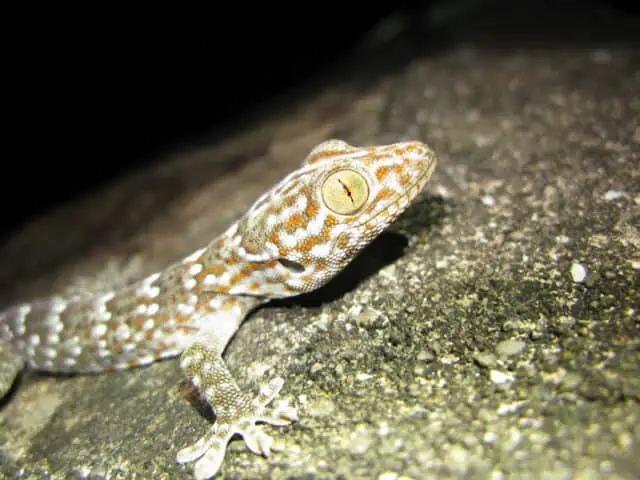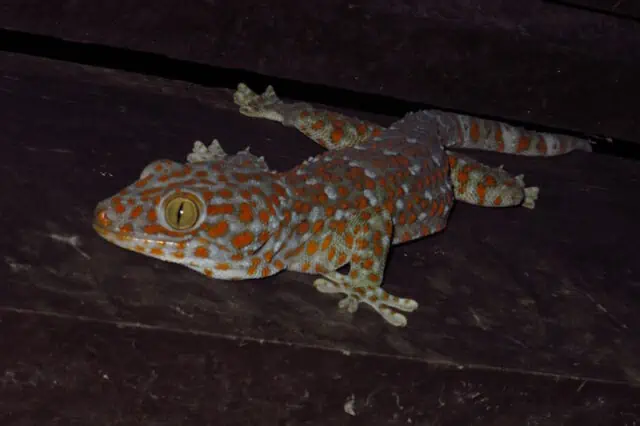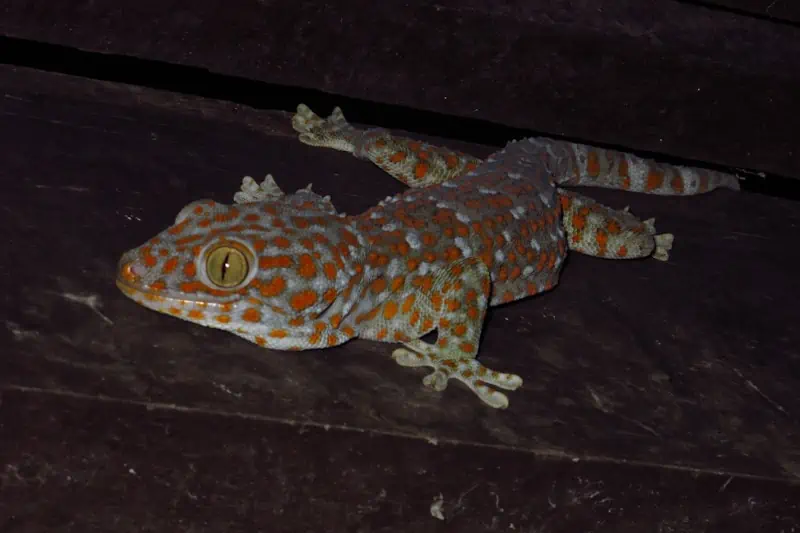Hey there, fellow reptile enthusiasts! Today, we’re going to take a journey into the intriguing world of Tokay Geckos and their fascinating mating rituals. As one of the largest gecko species, Tokay Geckos are a marvel to observe, and their mating behaviors are nothing short of fascinating. But why should we care about these rituals? Well, understanding these behaviors is crucial for breeders, pet owners, and herpetologists alike, as it helps ensure the species’ welfare and survival. So, buckle up, folks! We’re about to embark on an exciting exploration of the Tokay Gecko’s love life. Let’s get started, shall we?
Understanding the Tokay Gecko
Tokay Geckos, scientifically known as Gekko gecko, are a sight to behold. Native to Asia and some parts of the Pacific Islands, they’re admired for their vibrant coloration, robust bodies, and unique vocalizations. Males are generally larger than females, reaching up to 15 inches in length, and have a more pronounced preanal pore and hemipenal bulge.
Famously nocturnal, these geckos spend their days hidden away, coming out at night to hunt and, you guessed it, mate. They’ve gained notoriety for their loud vocalizations, which many say sound like “To-kay! To-kay!”. This unique call is not just a namesake; it plays a critical role in their mating behaviors, but more on that later.

In the wild, Tokay Geckos inhabit a variety of environments, from forests to human settlements. They are excellent climbers, thanks to their specialized toe pads, and are often found high up on trees or buildings. Their adaptability has allowed them to thrive in diverse habitats, reflecting their robust nature.
For breeders and pet owners, understanding the unique behaviors and preferences of Tokay Geckos is crucial. This knowledge allows us to replicate their natural environment as closely as possible, helping them lead healthy and fulfilling lives.
Pre-Mating Behavior of the Tokay Gecko
As we move closer to the Tokay Gecko’s mating season, you might start to notice some intriguing changes in their behavior. Their mating season typically coincides with the warmer months, when food is more abundant, though in captivity, where food and conditions are stable, they may breed year-round.
The male’s characteristic call, “To-kay! To-kay!”, isn’t just for show. It plays a crucial role in attracting a mate. During the breeding season, males vocalize more frequently and loudly, creating a chorus that can be heard over a considerable distance. This call serves a dual purpose: to entice females and to warn other males of their territory. A strong, resounding call is often a sign of a healthy and virile male – just what the female is looking for!
Females, on the other hand, respond with a softer, shorter call, indicating their receptivity to the male’s advances. They may also become more active, exploring their surroundings to locate a suitable nesting site for their future eggs. This increased activity is often a sign that the female is ready to mate.
Visual cues also play a significant role in the Tokay Gecko’s pre-mating behavior. Males display their bright coloration and may inflate their bodies, moving in a distinct manner to show off their size and fitness to potential mates. This courtship dance, if you will, helps the female identify a strong and suitable mate.
In captivity, observing these changes in your Tokay Gecko’s behavior can be a thrilling experience. Understanding these signs helps ensure a successful breeding attempt, and let’s be honest, who doesn’t enjoy a good gecko love story?
The Mating Ritual

Alright, so we’ve learned about the pre-mating behavior, now let’s get to the real action. The Tokay Gecko’s mating ritual is an intense, often fierce, affair. It may start out with the male approaching the receptive female. His approach isn’t as gentle as some might expect. Quite the opposite – it’s actually a bit aggressive.
Males may initially bite the female’s head or body to restrain her – a peculiar way of expressing love, don’t you think? This behavior might seem harsh to us, but in the world of Tokay Geckos, it’s par for the course. The male grips the female to maintain contact throughout the mating process, ensuring successful fertilization.
Females, too, play their part in this ritual. They might initially play hard to get, testing the male’s resolve and fitness. Once the male has proven his worth, the female allows him to mate with her.
The copulation may last for several minutes or even hours, during which the pair remain locked together. This part of the ritual is crucial for ensuring the successful fertilization of the eggs.
In captivity, it’s essential to monitor this process closely, as the male’s aggressive behavior can sometimes lead to injuries. Care should be taken to separate the pair if the interaction becomes overly violent. However, a certain level of roughness is normal and should be expected during the Tokay Gecko’s mating process.
After mating, the pair often go their separate ways. But the story doesn’t end here.
Post-Mating Behavior and Reproduction
Phew! The intensity of the Tokay Gecko mating ritual sure is something, isn’t it? But once that’s over, it’s time for the next chapter in this Gecko love story. Post-mating, the female begins the process of egg development and laying.
The female Tokay Gecko typically lays a clutch of one or two hard-shelled eggs about four weeks after mating. Here’s an interesting fact for you – these geckos exhibit oviparity, which means the female produces eggs that develop and hatch outside her body. During this period, she may become more secretive and protective, seeking out secluded spots where she can lay her eggs safely.
Now, here’s the thing about Tokay Geckos – they’re very particular about where they lay their eggs. Females often choose hidden spots that offer protection from predators and harsh environmental conditions. In captivity, providing ample hiding places and maintaining ideal temperature and humidity levels is crucial for successful egg laying and incubation.
Once the eggs are laid, they adhere to the surface they are laid on, whether it be a tree bark, wall, or a rock, and can’t be moved without causing harm. This sticking mechanism offers an extra layer of protection for the unhatched geckos. The female doesn’t engage in parental care, leaving the eggs to incubate and hatch on their own.
The incubation period typically lasts about two to three months, after which tiny geckos emerge from the eggs. These hatchlings are independent from birth, ready to take on the world. They’re miniature versions of their parents, equipped with everything they need to survive.
Understanding and supporting the post-mating process is key to ensuring the survival and health of the next generation of Tokay Geckos. After all, who wouldn’t want to see more of these fascinating creatures in the world?
The Impact of Environment on Mating
The Tokay Gecko’s mating habits aren’t just about the geckos themselves; they’re also heavily influenced by their environment. These geckos are adaptable creatures, inhabiting diverse environments from forests to human habitations. But when it comes to mating, certain environmental conditions can significantly impact their behaviors and success.
One key factor is temperature. Tokay Geckos, like most reptiles, are ectothermic, meaning their body temperature is regulated by the external environment. Warmer temperatures not only indicate the start of the breeding season but also directly impact the geckos’ metabolism, activity levels, and fertility. In cooler conditions, the Tokay Geckos might delay their breeding activities until more favorable temperatures arise.
Humidity is another critical factor. Tokay Geckos hail from regions with high humidity, and this moisture-rich environment plays a vital role in their mating behaviors. Adequate humidity levels can impact egg health, affecting the success of incubation and the survival rate of the hatchlings.
Lighting can also play a role. As nocturnal creatures, Tokay Geckos conduct most of their breeding activities during the night. This preference for darkness can impact when and how they mate, especially in captivity, where light conditions can be more easily controlled.
In the wild, availability of food and resources also directly influences the timing and success of the breeding season. Abundant food allows the geckos to build up energy reserves, essential for mating and egg production.
In captivity, maintaining an optimal environment that closely mimics the geckos’ natural habitat is crucial. Carefully controlling the temperature, humidity, lighting, and diet can significantly impact the success of your Tokay Geckos’ mating efforts.
Human Interaction and Its Effect on Tokay Gecko Mating
As we journey deeper into the world of the Tokay Gecko, it’s time to take a look at ourselves, the humans, and our impact on these extraordinary creatures and their mating rituals. In the wild, human interaction can often disrupt the natural behavior of these geckos, but in captivity, it’s a whole different ball game.
In the wild, habitat loss due to deforestation and urbanization is a significant threat to the Tokay Gecko population. Destruction of their natural habitats can disrupt their mating habits and lead to population decline. Noise pollution can also interfere with their vocal communication, making it challenging for males to attract females or defend their territories.
On the flip side, in captivity, human interaction takes on a different role. Here, we have the power to create an environment conducive to the Tokay Gecko’s mating behaviors. As we’ve learned, factors like temperature, humidity, and diet play a crucial role in their mating habits. By carefully controlling these factors, we can enhance the geckos’ wellbeing and boost their breeding success.
However, even in captivity, it’s crucial to respect the geckos’ natural behaviors. Excessive handling or disruption can stress the geckos, impacting their health and potentially disrupting their mating activities. Observation from a respectful distance is often the best approach.
Also, it’s important to remember that captive breeding programs should aim to maintain the genetic diversity of the species and ensure the welfare of the individual geckos. Breeding should never be about producing the most offspring, but about preserving the species and respecting their natural behaviors.
As we near the end of our exploration, it’s crucial to reflect on the impact we humans can have on these remarkable creatures. By understanding and respecting their mating rituals and behaviors, we can contribute to the survival and prosperity of the Tokay Gecko.
Conclusion
Well, there you have it, folks! We’ve journeyed through the fascinating world of Tokay Geckos and their intriguing mating rituals. From understanding the unique physical and behavioral characteristics of these beautiful creatures to uncovering their pre-mating signals, the intense mating ritual, and post-mating behavior, we’ve covered quite a bit of ground.
We’ve also learned about the significant impact that the environment has on Tokay Gecko mating habits, and the critical role we, as humans, play in this process, especially in a captive environment. Remember, understanding and respecting these natural behaviors is crucial to ensuring the wellbeing of the geckos and the success of any breeding efforts.
The world of the Tokay Gecko is full of intriguing behaviors, vibrant colors, and captivating sounds. Whether you’re a seasoned herpetologist, a reptile enthusiast, or a curious reader, there’s always more to learn and discover about these fantastic creatures. So, let’s continue exploring, observing, and respecting the incredible diversity of life that shares our world.
Frequently Asked Questions (FAQs)
How often do Tokay Geckos mate?
In the wild, Tokay Geckos typically mate during the warmer months, when food is abundant. However, in captivity, with a consistent food supply and stable environmental conditions, they may mate year-round. It’s important to note that the female needs time to rest and replenish her energy reserves between egg-laying events.
How can I tell if my Tokay Geckos are ready to mate?
Males will vocalize more frequently and loudly, displaying their vibrant colors and moving in a distinct manner. Females respond with a softer, shorter call and become more active, searching for suitable nesting sites. These are strong indications that your geckos are ready to mate.
What should I do if the male Tokay Gecko becomes overly aggressive during mating?
While a certain level of aggression is normal, if the interaction becomes overly violent, it may be necessary to separate the pair to prevent injuries. A suitable enclosure with plenty of space can help minimize conflict.
How can I ensure a successful breeding process in captivity?
Creating an optimal environment that closely mimics the geckos’ natural habitat is key. This involves carefully controlling factors such as temperature, humidity, lighting, and diet. Providing plenty of hiding spots and ensuring minimum disruption can also significantly improve breeding success.
How can I create an optimal environment for my Tokay Geckos to mate and lay eggs?
Maintaining the enclosure’s temperature around 80-90°F (27-32°C) and humidity levels between 70-90% can create an ideal environment. Provide a variety of hiding spots and climbing surfaces for your geckos. Remember, they’re nocturnal creatures, so appropriate lighting that simulates a natural day-night cycle is crucial.
What are some signs that my female Tokay Gecko is ready to lay her eggs?
Post-mating, the female will become more secretive and protective, seeking out secluded spots. She might also appear larger as the eggs develop inside her. These are signs that she’s preparing to lay her eggs.
What care should I provide for the eggs and hatchlings?
Once the eggs are laid, they shouldn’t be moved as this could cause harm. Maintain optimal temperature and humidity levels to support healthy incubation. Hatchlings are independent from birth and don’t require parental care, but ensuring a safe, appropriate environment with access to smaller prey items will help them thrive.





